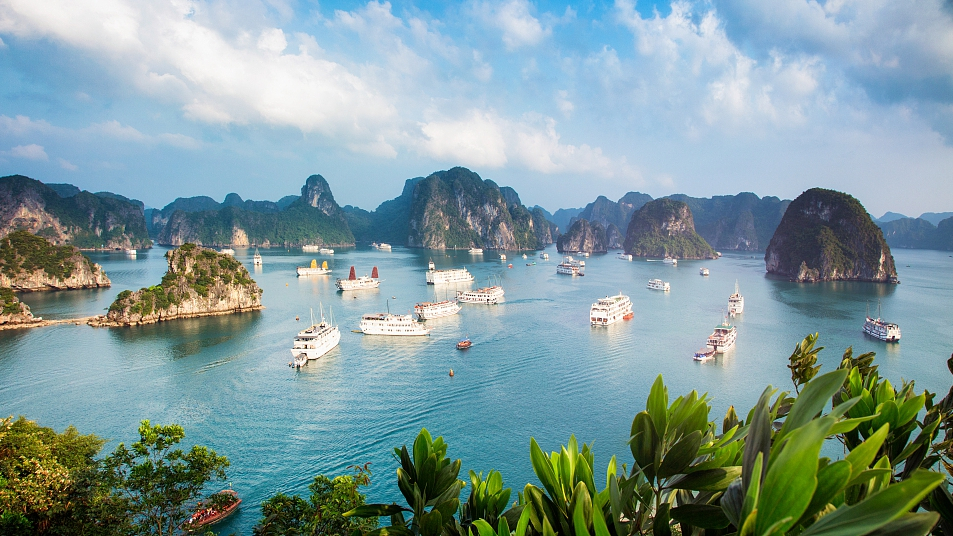Stretching from north to south like a dragon, this thin and long country of Vietnam features three different microclimates, which make it a great year-round destination in South East Asia. October to April is seen as the peak time to travel to Vietnam, as the country sees the least amount of rain during this time.
However, when the rains come to the north and south of Vietnam during the rest of the year, the central region of Vietnam stays dry and hot. The famous site of Halong Bay is best seen in October and November, and the vibrant Mekong River Delta between October and May.
Contents
Guide to Traveling in Vietnam
Vietnam is located in both a tropical and a temperate zone, and the climate varies greatly from North to South. There is always nice sunny weather all year round for you to visit the country.
Jan & Feb
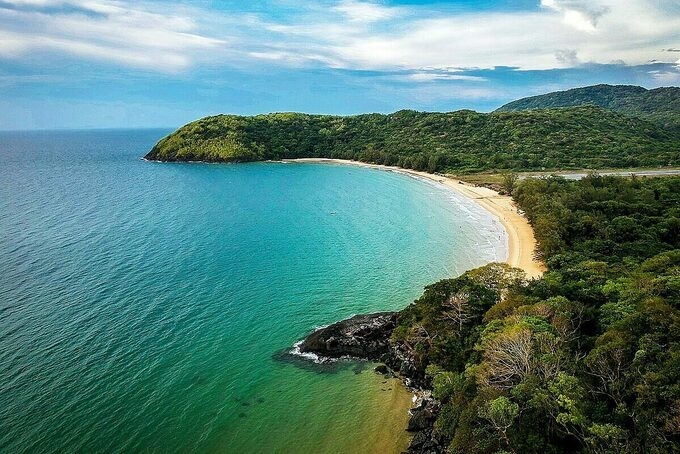
Vietnam in January and February is the peak tourism season, meaning popular destinations will be crowded. Nights in North Vietnam are quite cold, so if traveling at this time, it’s advisable to bring warm clothes for touring days, especially in the mountains of Sapa. In the morning, Halong Bay is covered in a thick mist, a serene and cloudy backdrop for a calming excursion. Along the coast of central Vietnam, the winter is warmer: the average temperature ranges from 20°C (68°F) in Hue and Hoi An to 24°C (75°F) in Nha Trang. Phu Quoc and Con Dao islands in the south are around 27°C (81°F) and have guaranteed sunshine.
The country is very colorful and charming this time, as the Vietnamese are preparing for their biggest traditional New Year Holiday. Visiting Vietnam this time of the year is therefore interesting; however, prices will also be higher as of their New Year.
Average Temperature in Cities:
| Sapa | Hanoi & Halong Bay | Hue & Hoi An | Nha Trang | Saigon & Con Dao Islands |
| 8°C/ 47°F | 15°C/ 60°F | 20°C/ 68°F | 24°C/ 75°F | 27°C/ 81°F |
HOLIDAYS & EVENTS
- February 5, 2019 (Pig): Tet or Lunar New Year (same as Chinese New Year) is Vietnamese’s biggest traditional holiday, when people travel home to enjoy family time for a week. Streets, shops, and houses are well cleaned and decorated with red and yellow, which are considered good luck and prosperity. In Ho Chi Minh City, and virtually everywhere else in the country, parades – rife with dancing and music – fill the streets. See stunning fireworks displays in larger cities.
- February 17: The Lim Festival takes place in the town of Lim to celebrate Nguyen Dinh Dien, an 18th-century resident of the area who, according to Buddhist tradition, amassed much merit for the community. Stages are built in several communities, featuring folk music and dancing.
MUST SEE
- Tet New Year – the most important holiday in Vietnam – brings a striking shade of red that dominates cities and towns. Ornate parades and dragon costumes take over the streets, and thrilling fireworks displays in larger cities, such as Ho Chi Minh City and Hanoi, take over the skies.
- Hoi An Lantern Festival – The festival takes place every 14th day of every lunar month in the town of Hoi An in preparation for the full moon. Small paper lanterns with candles inside are set down the Thu Bon River as an offering to ancestors and local gods.
Mar & Apr

March and April are the last two months of the peak season in Vietnam. While there’s more to do in terms of attractions, popular sites and cities are still crowded – and likely more expensive.
Temperatures begin to climb from the end of April, creating higher humidity. The mist over Halong Bay clears away, revealing the reflection of blue skies on the water’s surface, and the temperature is around 25°C (77°F). Before the temperatures get too warm in the north, you can experience a relatively comfortable climate with low humidity.
The beaches in Hue and Hoi An in central Vietnam are in full summer mode, basking in constant sunshine with an average temperature of 26°C (79°F). Towards the south, Nha Trang beach is enjoying blue skies and higher temperatures, falling around 27°C (81°F)
The weather in Saigon remains dry, and the beaches on Phu Quoc and Con Dao Islands are the best for beach breaks. The average temperature is 30°C (86°F). March is Favorable diving conditions in Con Dao Islands, with visibility averaging 20-30 meters (65 – 98 ft.).
Average Temperature in Cities:
Sapa | Hanoi & Halong Bay | Hue & Hoi An | Nha Trang | Saigon & Con Dao Islands |
15°C/ 59°F | 25°C/ 77°F | 26°C/ 79°F | 26°C/ 79°F | 30°C/ 86°F |
HOLIDAYS & EVENTS
- In early March, the Perfume Pagoda Festival takes place when the pilgrimage to the Perfume Pagoda, the most popular pilgrimage site in Vietnam, attracts hundreds of thousands of people. Many come from all over to pray and worship together.
- April 4, the Phu Giay Festival – a celebration during the first ten days of the third lunar month in the village of Phu Giay. Celebrating the Mother Saint Lieu Hanh, a procession of women in the village climbs to the two area temples and makes offerings in her honor.
- Late April – early May, the Hue Festival celebrates the culture of the city of Hue. From a massive stage, ornate celebrations in dance and music amid neon lights entertain thousands who visit the city.
- Apr 30, Reunification Day, or Day of Liberating the South for National Reunification – is a public holiday in Vietnam that marks the event when Vietcong and North Vietnamese troops captured Saigon (now Ho Chi Minh City) on April 30, 1975.
MUST SEE
As the mist over Halong Bay has cleared away, the bright blue skies create a stunning reflection off the water. Navigating between the small islands jutting into the sky along slow waters, few places are as beautiful and serene in Vietnam.
May & Jun
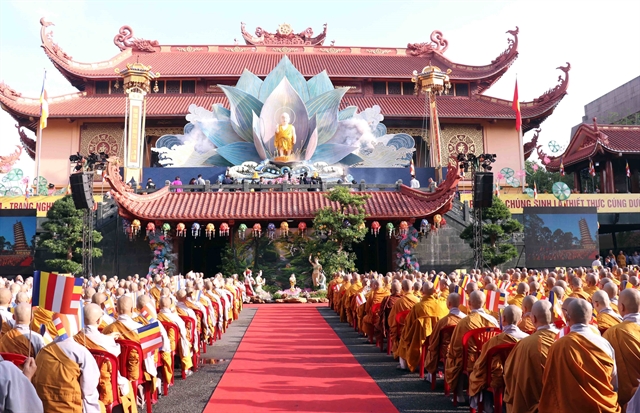
May and June in Vietnam are the low tourism season, so prices will be lower as boats and hotels start offering different promotions. However, this time of the year is high season for Vietnamese tourists traveling with their families, so beaches are more crowded.
Temperatures are rising in the north, while the dry season comes to an end in the south. Traveling to the country this time will reward you with fresh low low-season prices; sites are getting fewer Western tourists.
Particularly, Sapa sees summer arriving with temperatures settling between 18°C and 22°C, and 5 hours of sunshine per day. Tourists to the area can expect rainfall with an average of 307mm precipitation during this time of the year. Odd showers are quite frequently seen in the north, but there are clear blue skies for the majority of the time in Hanoi, Halong Bay.
The best place to be in Vietnam this time is perhaps the central parts, where you will enjoy the sun with very little rain. Hoi An, Hue, and Danang in the center of Vietnam experience warm and dry weather, with average temperatures of 30°C (86°F).
Monsoon season also begins in the south, from May through November, expect tropical downpours in the afternoon. However, travel is rarely affected by the rain, and everything is lush and green at this time. Much closer to the equator, Saigon experiences consistently warm temperatures year-round, with balmy days averaging around 28°C (82°F). The levels of the Mekong Delta rise from the falling rains, making it easier to sail on clear days.
Average Temperature in Cities:
| Sapa | Hanoi & Halong Bay | Hue & Hoi An | Nha Trang | Saigon & Con Dao Islands |
| 20°C/ 68°F | 32°C/ 90°F | 30°C/ 86°F | 28°C/ 82°F | 28°C/ 82°F |
HOLIDAYS & EVENTS
- May 12: The Buddha’s birthday is one of the most important holidays in Mahayana Buddhism, which is practiced in Vietnam. Pagodas around the country are decorated, and thousands of monks will travel to pray and meditate together.
- May 19: Ho Chi Minh’s Birthday
MUST SEE
Vietnam celebrates the birth of Ho Chi Minh, a revolutionary leader who helped secure the country’s independence and led its communist government until 1969. Government officials hold a memorial ceremony in his honor, and patriotic festivals, film screenings, and other events examining Vietnam’s progress take place.
Jul & Aug

July and August in Vietnam are low tourism season, so prices will be lower, boats and hotels offer different promotions. If you don’t mind a few showers, it is still worth visiting places in Vietnam this time of the year.
It’s summer in Hanoi and Halong Bay, and bringing heat and humidity, with average temperatures at 30°C (86°F), accompanied by refreshingly short bouts of heavy rain. These tropical downpours generally arrive in the afternoons, and despite being wet, summer months have the highest number of hours of sunshine.
The nicest weather is in central Vietnam, where you will enjoy sunny days on the sandy beaches. The beaches of Hoi An and Danang, with an average temperature of 30°C (86°F), are still the pick of the bunch with good weather expected throughout the month.
Saigon and Con Dao Islands are now firmly into their wet season; however, this is unlikely to be severe. Travelers can still expect plenty of dry and bright daylight hours with an average temperature of 28°C (82°F). From mid-August, Green Turtle hatchlings can be observed emerging from the beaches on Con Dao Islands and making their first steps to the sea.
Average Temperature in Cities:
| Sapa | Hanoi & Halong Bay | Hue & Hoi An | Nha Trang | Saigon & Con Dao Islands |
| 20°C/ 68°F | 30°C/ 86°F | 30°C/ 86°F | 28°C/ 82°F | 28°C/ 82°F |
HOLIDAYS & EVENTS
- August 25, Wandering Souls Day – takes place on the 15th day of the 7th lunar month, on which Vietnamese believe that spirits of their ancestors are able to visit their homes. On the eve of the festival, families flock to Buddhist temples and graves of their departed loved ones to offer prayers, flowers, sticky rice cakes, and fruits. Paper money and clothes are also burned for their spirits.
- Mid-Autumn Festival – a harvest festival celebrated by Vietnamese people, which is held on the 15th day of the 8th month of the lunar calendar with a full moon at night. Offerings are prepared at pagodas and temples; colorful toys are made for children. Hoi An is the most beautiful town this time of the year; the whole town is full of yellow and red lanterns.
MUST SEE
Wandering Souls Day is a Buddhist tradition celebrating the release of souls trapped in Hell for one day. Paper lanterns are sent down local rivers, and offerings of food are laid out for deceased relatives.
Sep & Oct
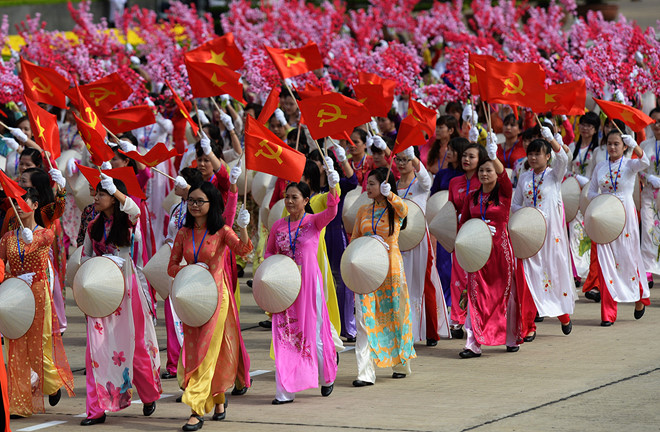
September is still part of the low tourism season in Vietnam, but the season begins peaking around October, so expect prices to increase and crowds at popular attractions.
North Vietnam in September is edging towards the end of its summer, although you can still expect plenty of hot weather as well as some rain. Towards the end of the month, in particular, the temperature starts to drop a little and the rainfall becomes less frequent. In the mountains, the endless rice fields of Mai Chau, Mu Cang Chai, and Sapa turn a golden color, ready to harvest. The pleasant weather this time offers Mai Chau and Sapa some of the best trekking conditions of the year.
October sees the end of the wet season in the north, and as the month moves on, the temperature drops, as does the rainfall, especially in the second half of the month. The cooler, dry winter approaches with an average temperature of 27°C (81°F). This is the best time to cruise the calm waters of Halong Bay, and to visit the colonial city of Hanoi as well as the mountain areas.
Along the central coast, the weather is ready for a change in September. The rain is on the increase in Hoi An and Hue, which can cause flooding. In October, the rainfall is close to its peak, and heavy storms can occur, so Hoi An is prone to flooding. The temperatures in Hoi An and Hue differ slightly, with an average of 26°C (79°F).
The beaches of Nha Trang start to see an increase in rain, plenty of rain with nearly half the city’s annual rainfall falling in October and November.
Further to the south, Saigon and Con Dao Islands see rainfall on the decline, especially towards the end of October, as the region moves towards its dry, warm summer months with an average temperature of 27°C (81°F). The islands of Phu Quoc & Con Dao are starting to recover from the winter months, and the sun starts to shine once again. Around the islands of Con Dao, Green Turtle hatchlings continue to emerge from their nesting grounds under the sand and make their first steps to the sea.
Average Temperature in Cities:
| Sapa | Hanoi & Halong Bay | Hue & Hoi An | Nha Trang | Saigon & Con Dao Islands |
| 17°C/ 63°F | 27°C/ 81°F | 27°C/ 81°F | 26°C/ 79°F | 27°C/ 81°F |
HOLIDAYS & EVENTS
- September 2, Vietnam Independence Day – a national holiday commemorating the Vietnam Declaration of Independence from the Japanese in 1945.
- September 13, the Mid-Autumn Festival – an ancient celebration of the rice harvest, celebrated across much of East Asia. Friends and family come together, enjoying company and moon cakes, a traditional delicacy.
MUST SEE
National Day in Vietnam celebrates the reunification of the country after the Vietnam War. Patriotism floods the country – speeches and parades fill public squares, and fireworks light up the skies.
Nov & Dec
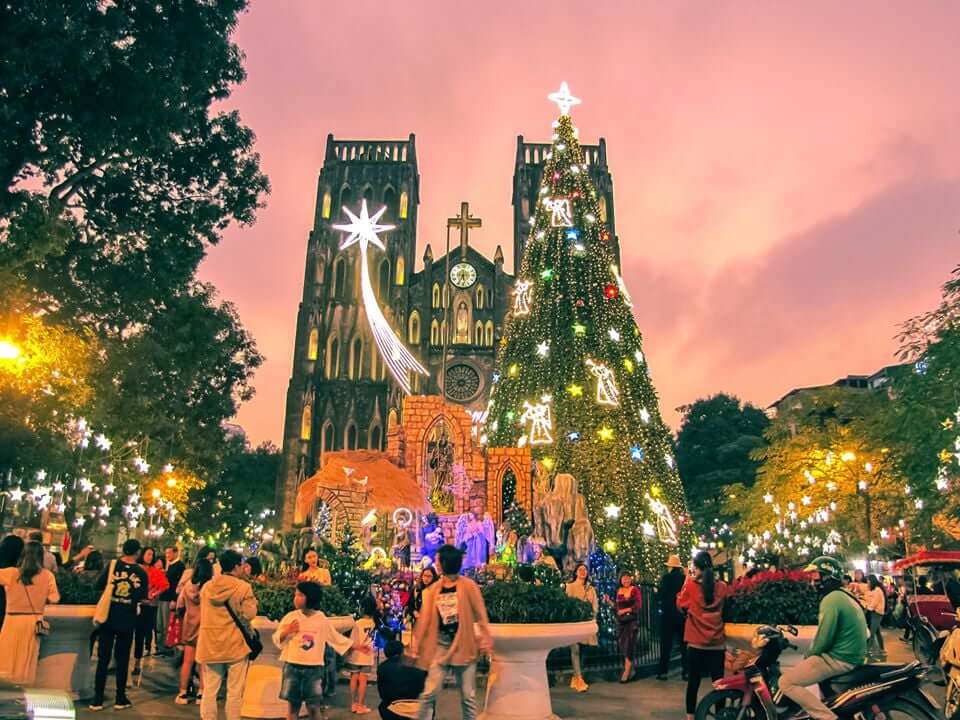
November through December is peak tourism season in Vietnam, meaning popular destinations will be crowded and hotel prices are a bit higher.
All across the country, most regions experience low humidity!
In the north, the weather in the mountainous regions of Mai Chau, Mu Cang Chai, Sapa, and Ha Giang is dry with clear days promising some of the best trekking conditions of the year. However, it can be cold, especially in the evenings, so suitable clothing is recommended.
Hanoi and Halong Bay are now enjoying some of the best conditions of the year; the weather is dry and pleasant with temperatures around 20°C (68°F). November through December is one of the driest months of the year in Hanoi and the north, and is also considered to be one of the best months to experience a junk cruise on Halong Bay.
The rainfall in the center of the country is at its peak, and heavy storms can occur. Hoi An, in particular, is prone to flooding in November. In December, more rainfall is expected in Hue; the region temperatures are close to their lowest for the year at 23°C (74°F), although still far from chilly.
Sitting in its own micro-weather system, Nha Trang will see rainfall, although this steadily declines through November.
Further south, the Mekong Delta welcomes back the summer in all its glory with some of the best weather of the year, and the beaches within easy reach of Saigon are experiencing blue skies and plenty of sunshine. The islands of Phu Quoc and Con Dao are also enjoying warm, dry weather with an average temperature of 27°C/ 81°F, making the southern beaches the pick of the bunch in November.
Average Temperature in Cities:
| Sapa | Hanoi & Halong Bay | Hue & Hoi An | Nha Trang | Saigon & Con Dao Islands |
| 12°C/ 54°F | 20°C/ 68°F | 23°C/ 74°F | 25°C/ 77°F | 27°C/ 81°F |
HOLIDAYS & EVENTS
- December 25, Christmas is a big holiday in Vietnam – at times as lively as in Western countries, with costumed Santas parading through the streets of many large cities – expect parades, performances, and people in Santa costumes, especially in larger cities.
MUST SEE
Though the majority of religiously affiliated people in Vietnam are Buddhist, Christmas brings both Christians and non-Christians together. A walk through Hanoi’s neighborhoods, you’ll see shoes left on the porch in anticipation of Santa leaving gifts. City and town squares are decorated with traditional red, white, and green decorations, and Christmas carols fill the air.

